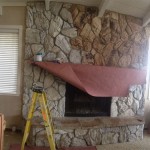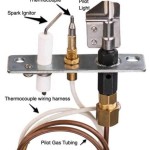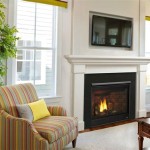How To Build an Outdoor Fireplace Out Of Cinder Block
An outdoor fireplace constructed from cinder blocks offers a durable and cost-effective addition to any backyard patio or garden. Cinder block, also known as concrete masonry units (CMUs), provides a robust and fire-resistant material suitable for containing high temperatures. The construction process, while requiring physical labor, is relatively straightforward and can be accomplished by individuals with basic construction skills. This article outlines the steps involved in planning, building, and finishing an outdoor fireplace using cinder blocks.
Planning and Preparation
Before commencing construction, meticulous planning is crucial. This phase involves determining the fireplace's dimensions, design, and location. Furthermore, compliance with local building codes and regulations must be verified. A well-defined plan ensures a structurally sound and aesthetically pleasing final product.
First, consider the intended use of the fireplace. Will it primarily serve as a source of warmth or as a cooking appliance? This will influence the size and configuration of the firebox. Larger fireboxes are suitable for burning larger logs and providing more heat, while smaller fireboxes are sufficient for smaller fires or cooking purposes. Consider functionalities like installing a grill grate, chimney height, and overall aesthetic appeal.
Next, select a suitable location for the fireplace. The fireplace should be situated away from flammable materials, such as trees, fences, and overhanging structures. A minimum clearance of ten feet is generally recommended. Account for prevailing wind direction to minimize smoke nuisance to surrounding properties. Consider the proximity to seating areas to maximize enjoyment of the fireplace.
The location should also be relatively level and well-drained. Poor drainage can lead to water accumulation around the base of the fireplace, potentially compromising its structural integrity over time. If the ground is not naturally level, it must be graded and compacted before construction begins.
Developing a detailed design plan can prevent costly errors. Sketch the fireplace, noting the dimensions of each component, including the base, firebox, chimney, and any decorative elements. This plan will serve as a guide during the construction process. It is important to calculate material requirements accurately. Estimate the number of cinder blocks needed for each course (layer) of the fireplace, including any blocks that will need to be cut. Account for waste and breakage when ordering materials.
Equally important is verifying local building codes and regulations. Many municipalities have specific requirements for outdoor fireplaces, including setback distances from property lines, chimney height restrictions, and fire safety regulations. Contacting the local building department is essential to ensure compliance. Obtain any necessary permits before starting construction. Failure to comply with building codes can result in fines, delays, or even the forced removal of the fireplace.
Acquire all necessary materials and tools. Essential materials include: cinder blocks, mortar mix, fire bricks (for the firebox lining), gravel (for the base), sand (for leveling), and chimney liner (if required by code). It's also essential to get the required personal protective equipment. Required tools include: a shovel, a level, a measuring tape, a trowel, a mixing tub or wheelbarrow, a mortar hoe, a brick hammer, safety glasses, work gloves, and a saw with a masonry blade (for cutting cinder blocks).
Constructing the Fireplace
The actual construction process involves laying the foundation, building the base and firebox, constructing the chimney, and applying any desired finishing touches. Accuracy and attention to detail are crucial at each stage to ensure a structurally sound and aesthetically pleasing fireplace.
Begin by preparing the foundation. Excavate the area where the fireplace will be built to a depth of approximately six inches. The excavation should be slightly larger than the footprint of the fireplace base. Add a layer of gravel to the excavated area, compacting it firmly. This gravel base provides drainage and helps to prevent settling. Pour a concrete footing, ensuring it is level and flush with the surrounding ground, and allow the concrete to cure completely according to the manufacturer's instructions. Curing time typically ranges from 24 to 72 hours. This footing provides a solid, level base for the cinder block structure.
Next, lay the first course of cinder blocks. Mix the mortar according to the manufacturer's instructions. The mortar should have a consistency similar to thick peanut butter. Apply a generous layer of mortar to the concrete footing and carefully position the first cinder block. Use a level to ensure that the block is perfectly level both horizontally and vertically. Continue laying the remaining blocks in the first course, using a trowel to apply mortar between each block. Remove any excess mortar with the trowel. Check the level of the entire course frequently to ensure that it is perfectly level. These steps are critical to ensure that the rest of the structure is stable.
Stagger the joints on subsequent courses. This technique, known as overlapping, strengthens the structure by distributing the weight evenly. Apply mortar to the top of each block and to the vertical faces of the blocks being laid. Use a level to ensure that each block is level and plumb (vertically aligned). As you build up the walls of the fireplace, periodically check the overall dimensions to ensure that the structure is square. Use a square or a builder's square to check the corners. Ensure that all blocks are fully supported with mortar. Fill all voids and gaps with mortar on the interior for added fire safety.
Line the firebox with fire bricks. Fire bricks are designed to withstand extremely high temperatures. Apply a layer of fire-resistant mortar to the back of each fire brick and carefully position it inside the firebox. Ensure that the fire bricks are tightly fitted together to create a seamless barrier. The fire brick lining should extend at least 24 inches above the fire grate. The fire brick lining will protect the cinder blocks from direct exposure to the flames and extend the lifespan of the fireplace.
Construct the chimney. The chimney is an essential component of the fireplace, as it vents the smoke away from the surrounding area. Build the chimney using the same cinder block and mortar technique as the base and firebox. Overlap the joints on each course to strengthen the chimney. As the chimney rises, gradually narrow its width to create a tapered shape. This taper helps to improve the draft and prevent downdrafts. Install a chimney liner inside the cinder block chimney. The chimney liner is a metal or ceramic pipe that protects the cinder blocks from the corrosive effects of the smoke and combustion gases. The chimney liner also helps to improve the draft and prevent creosote buildup. Most building codes require a chimney liner when constructing a masonry chimney.
Finishing and Safety
The final stage involves adding any desired finishing touches and ensuring that the fireplace is safe to use. This process often includes applying a decorative veneer, installing a fire grate, and performing a test burn.
Apply a decorative veneer to the exterior of the fireplace. This can be achieved using a variety of materials, such as stone, brick, or stucco. A veneer enhances the aesthetic appeal of the fireplace and protects the cinder blocks from the elements. Attach the veneer using a suitable adhesive or mortar. Ensure that the veneer is securely attached and that all joints are properly sealed. A well-applied veneer can significantly improve the appearance of the fireplace.
Install a fire grate inside the firebox. The fire grate elevates the firewood, allowing air to circulate underneath. This promotes more efficient combustion and reduces the amount of smoke produced. Choose a fire grate that is the appropriate size for the firebox. A fire grate made of heavy-duty steel is recommended for durability. The fire grate should be positioned in the center of the firebox.
Perform a test burn. Before using the fireplace for regular use, perform a small test burn to ensure that it is functioning properly. Start a small fire using dry kindling. Observe the draft to ensure that the smoke is venting properly through the chimney. Check for any leaks or cracks in the structure. Monitor the temperature of the exterior surfaces of the fireplace. If any problems are detected, address them before using the fireplace for regular use. Keep a fire extinguisher nearby in case of emergency. A thorough test burn is essential to ensure that the fireplace is safe to use.
Maintain the fireplace properly. Regular maintenance is essential to ensure that the fireplace remains safe and functional. Clean the firebox regularly to remove ashes and creosote buildup. Inspect the chimney for any signs of damage or blockage. Repair any cracks or leaks in the structure promptly. A well-maintained fireplace will provide years of enjoyment.
It's important to consider safety measures. Never leave a fire unattended. Keep children and pets away from the fireplace. Use a fire screen to prevent sparks from flying out. Ensure that the area around the fireplace is clear of flammable materials. Always extinguish the fire completely before leaving the area. Adhering to these safety precautions will help to prevent accidents and injuries.

How To Build An Outdoor Fireplace Contractor Broomfield Part 2

Concrete Block Outdoor Fireplace

Cinder Blocks Are Easy To Find For Free And They Have Almost Unlimited Diy Potential Here S Outdoor Fireplace Plans Backyard

How To Build An Outdoor Fireplace Step By Guide Buildwithroman

Diy Cinder Block Fire Pit Ideas Plans Pros And Cons

Backyard Fireplace Part 2 Milk Paint

Diy Cinder Block Fire Pit Ideas Plans Pros And Cons Designs

How We Built Our Outdoor Fireplace Chris Loves Julia

Outdoor Fireplace With Bench Seating W Tips From A Professional Mason

How To Make Cinder Block Fire Pits








